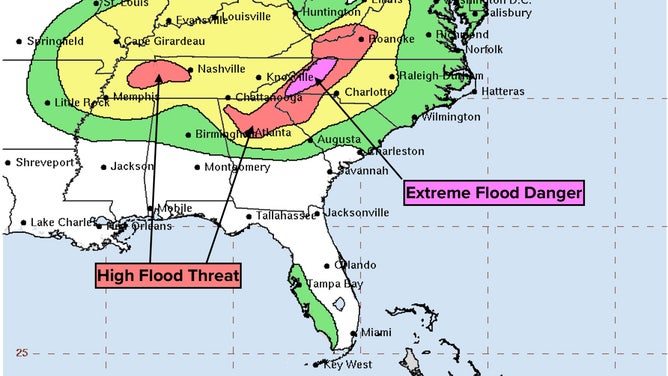Bryan Norcross: Catastrophic flooding inland from Helene after storm surge inundates west coast of Florida
Torrential rain caused a Flash Flood Emergency across a large part of metro Atlanta this morning, which will continue for some time. Flash Flood Emergencies are also in effect in the Carolinas, where flooding could be historic. There is extreme danger from rushing water in and around streams, creeks and rivers across the region.

FOX Weather is your Hurricane HQ.
(FOX Weather)
Updated at 10:30 a.m. on Friday, Sept. 27, 2024
The center of Tropical Storm Helene is racing through North Georgia into Tennessee. Torrential rain caused a Flash Flood Emergency across a large part of metro Atlanta this morning, which will continue for some time. Flash Flood Emergencies are also in effect in the Carolinas, where flooding could be historic. There is extreme danger from rushing water in and around streams, creeks and rivers across the region.
Flash flooding in hilly or mountainous areas is one of the deadliest hazards caused by tropical storms and hurricanes. Stay well-informed of alerts from the National Weather Service issued for your area.

This graphic shows the flood threat on Friday, Sept. 27, 2024.
(NOAA)
In Florida, unfortunately, the storm surge forecast for the west coast was correct. Gulf water inundated communities from Fort Myers and Naples in the south, through the Tampa Bay region, north to Cedar Key and the Big Bend in the north.
The winds around the back side of Hurricane Helene pushed the seawater about 6.5 feet above normal high tide level late last night along the beaches on the Gulf side of the Tampa Bay region. Inside the bay, the water was about 7 feet above ground that is normally dry. It would have been even higher if the peak surge had coincided with the high tide cycle, which came a few hours later. The National Hurricane Center forecast for Tampa Bay of up to 8 feet of surge was spectacularly good.
Storm surge is saltwater, so it takes a long time to completely recover from the flood. Vehicles and equipment often have to be scrapped. Use extreme care with anything electrical that was affected by the surge. Salt and electricity are not compatible and can cause fires.
Farther south in and around Fort Myers and Naples, the surge was over 5 feet above normal high tide, flooding towns and neighborhoods near the Gulf, the harbors and the rivers. Again, the forecast issued two days in advance was correct.
You've probably heard that the surge in the Tampa area was a record, but that's misleading. Big hurricanes of the past have pushed much higher surges across the region – notably in 1921 and 1848. The surge from Helene is a record since 1973, when the tide gauge was installed.
The Tampa Bay area has simply been exceptionally lucky to have escaped massive storm surge flooding through its explosive development years. It is, and it has always been, extraordinarily vulnerable to storm surge flooding.
Helene leaned slightly to the right side of the cone as it was making landfall just after 11 p.m. southeast of Tallahassee. The capital city was largely spared, although there was some wind damage. The smaller towns to the east and in South Georgia were likely severely impacted, however. It will take some time to evaluate all that has happened in that region.
Helene's widespread effects will go on for days. The incredible amount of rain falling at higher elevations has to eventually drain to the Atlantic and the Gulf. Rain and wind will spread north into the mid-South and the Midwest. By early next week, the system that was Helene will just be a moisture smudge spreading across the Northeast and out to sea.

Several areas are being watched in the Atlantic this week.
Elsewhere in the tropics, the National Hurricane Center is watching a number of areas. The systems out in the Atlantic show no signs of threatening land if and when they develop. There is a potential system to watch, however. The next names on the list are Joyce and Kirk.
A similar weather pattern to the one that generated Helene is forecast to set up over Central America. It could spawn yet another low-pressure area in the western Caribbean that could track into the Gulf next week. There is nothing to look at now, but it looks like this will be our area to watch going forward.